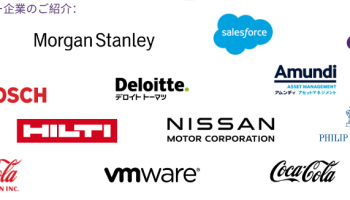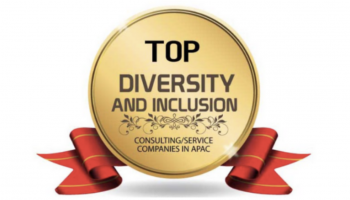One of the biggest topics amongst people and culture leaders that has been weaving its way into all of our conversations is that of retention and how to effectively retain top, diverse talent. Japan has been known to be one of the toughest markets to hire due to a severe talent shortage, with 128 jobs for every 100 applicants. The ratio becomes even bigger when it comes to bilingual talent, which is in very high demand. Due to these, we are now seeing a much bigger focus on retention, with 76% of companies mentioning employee retention as a concern. As organisations take stock of the significant investment they have made in attracting the best talent, they are now focusing on keeping them.
In this climate, organisations simply cannot afford not to prioritise retention. With the pace of turnover forecast to be 50–75% higher than previously experienced and the cost of attrition being up to 2-3 times the employee’s salary, organisations that get retention right will inevitably outperform those that don’t. Below, we share 3 ways to intentionally and effectively retain your top talent.
1. Build an inclusive workplace culture that people want to stay in
Consider not just what makes talent come to your organisation but also, what makes them stay. Those who say that they are “naturally inclusive” are missing the point – if we don’t intentionally include, then we unintentionally exclude.
The power has shifted to the employees and they will no longer tolerate a culture where they don’t feel included or supported by their manager. Yet, we expect that people leaders are naturally empathetic, caring and capable of responding appropriately to the myriad of challenges their direct reports may be facing, both within and outside of work. This is simply not the case. The reality is that people managers are often responsible for individuals with different and unique lived experiences and it’s unreasonable to expect that they will be naturally equipped to navigate all of the scenarios thrown at them.
Fortunately, there is a solution: equip them with the knowledge and tools to be an inclusive leader. Dedicated training can support individuals to identify and overcome biases and triggers that manifest in the workplace, provide best-practice tools to foster psychologically safe environments and guide them to take affirmative action towards building a truly inclusive culture.
At an organisational level, how are you ensuring that people are feeling included?
One of the most difficult components of creating and maintaining an inclusive workplace culture is incorporating equity, and many aren’t aware of the difference between equality and equity. Equality is when everyone is given the same resources or opportunities. Equity, however, recognises that each person has different circumstances and allocates the exact resources and opportunities needed to reach an equal outcome. Equity when it comes to inclusion means a one size fits all approach will not be effective. It is instead about providing access to different policies and opportunities that suit the individual, including flexible and hybrid working arrangements and tailored progression plans.
2. Provide meaningful development and advancement opportunities
The number one reason talent leave their organisation is due to a lack of development opportunities and this is particularly pertinent for mid-career female talent. If you are seeking an increase in diversity amongst your Executive leadership team, how are you creating meaningful, tailored opportunities for top talent to advance in your organisation?
Do your high potential talent have clarity around their development plan?
For high-calibre talent that you see progressing in the organisation, it’s essential to ensure that they understand the progression opportunities available to them and and have clear expectations of how they can get there. Dedicated leadership development training can help in identifying and overcoming personal barriers to becoming a leader and equip them with the tools needed to succeed in the corporate environment.
Organisations that are nailing retention across the organisation are looking beyond their individual team and providing opportunities for talent to move laterally into different teams to embrace new opportunities. This increases the likelihood that employees that are keen to try something different, which we’re seeing more and more frequently with younger generations entering the workforce, with opportunities within the organisation, rather than seeking opportunities in different externally.
3. Go to the source
It’s baffling how often an organisation will make a decision for its people without consulting them. Decisions made around an executive table with no input from lower levels are a recipe for disaster. How are you intentionally inviting and actioning input from different levels of the organisation?
- Consider the representation and segmentation of the people you’re inviting input from.
Are all voices being heard? If utilising employee sentiment surveys, it’s crucial to analyse the results according to different diversity groups, rather than painting an inaccruate picture based on averaging data across the broader organisation. - Listen to understand, with no agenda.
1:1 conversations or small internal focus groups can be really effective in uncovering the real, “on the ground” sentiment. Create the space for employees to share openly without seeking feedback that enforces or disproves a theory that you already have, this bias will inevitably shape the conversation and minimise the likelihood of gathering the most relevant feedback. - How are you responding to and implementing feedback given?
When seeking specific feedback on a new initiative or policy, make sure to invite input at a stage where they can influence the direction. There’s no use asking for contributions once something has already been locked in and isn’t going to be changed, this is more damaging than not seeking feedback in the first place.
Building an inclusive workplace culture that effectively and equitably supports a diverse range of individuals is challenging and is an ongoing process and evolution. Yet the reward when organisations get it right is well worth the time, energy and financial investment. Those that are intentional and prioritise the retention of their top talent will gain a competitive advantage and emerge ahead of those that don’t.
Would you like to speak to one of our diversity, equity and inclusion experts on your talent retention strategy?
リテンション対策をあらためて考える
今、人事や組織文化の専門家やリーダーたちの間で、多様かつトップクラスの人材が効果的に勤続する方法、つまりリテンション(離職防止)について話題になることが少なくありません。日本は、応募者数が100人に対して128件の求人があるという厳しい人材不足市場であるため、採用が非常に困難な市場として知られています。バイリンガルの人材になると、さらに引く手あまたなのです。そのため、従業員の定着に重点を置く企業が増えてきていますが、76%の企業が従業員の定着を懸念しています。採用に多大な投資をし、トップクラスの人材を獲得した企業は、さらに彼らを維持することに焦点を当てるようになっています。
しかしながら、このような人材不足の状況下では、企業は単にリテンションを優先することができなくなっています。従業員の離職率は、以前よりも50〜75%増で推定され、離職のコストは従業員の給与の2〜3倍になるとも言われています。ここで、効果的なリテンション対策を実施する企業は、それを行わない企業よりも必然的に優位に立つことになります。以下では、優秀な人材を意図的かつ効果的に定着させるための3つの方法を共有しています。
1. 定着させたい職場文化を構築する
人材を企業に惹きつける要因だけでなく、企業にとどまりたい理由についても考慮することが重要です。自分たちが「私たちの職場はもともとインクルーシブです」と言う人々は、思い過ごしがあるかもしれません。意図的にインクルージョンを心がけない場合、気づかぬうちに排他してしまうことになるからです。
従業員は自分たちがマネージャーによって歓迎されていないと感じる文化では、力も発揮できず、徐々に耐えられなくなるでしょう。私たちは言わずとも、リーダーは自然に共感してくれて思いやりがある、直属の上司は、多くの課題に直面しても適切に対処できると期待していますが、現実はそうではありません。私たち上司自身も、責任や意思決定を、個人の経験値に委ねられることが多く、彼らは当然、直面するすべてのシナリオに卒なく対応できるだろうと、期待するのは不合理です。
幸い、ここに解決策があります。インクルーシブなリーダーになるための知識やツールを提供することで、個人を支援し、職場に潜むバイアスや課題を特定します。そして、心理的に安全な職場環境を醸成するためのベストプラクティスを提供し、真にインクルーシブな企業文化を構築するために積極的な行動するよう促すことができます。
さて、組織レベルでは、どのようにして人々が歓迎されていると感じられると言えるでしょうか?
インクルーシブな職場文化を醸成および維持する最も難易度が高い要素の1つは、エクイティを組み込むことです。多くの人々は、平等とエクイティ(公平)の違いが何か、あまり区別がついていません。。平等とは、すべての人が同じリソースや機会を与えられることです。ただし、エクイティは、各人が異なる状況を持っていることを認識し、それぞれに合った最適なリソースや機会を割り当てる、つまり同等の結果を達成するために必要なツールを提供します。インクルージョンにおける公平性を考えると、1つのサイズがすべてに合わないということがわかります。代わりに、一人ひとりに適したさまざまなポリシーや機会へのアクセスを提供することが重要となります。具体的には、柔軟でハイブリッドな労働環境やカスタマイズされた人材開発プランなどが該当します。
2. 有意義な開発および昇進の機会を提供する
優秀な人材が組織を去る最大の理由は、成長の機会がないことです。特に中堅の女性人材にとっては、この問題が顕著です。エグゼクティブ層において多様なリーダーを増やしたい場合、優秀な人材が組織内で成長・昇進できるべく、一人ひとりに合わせてカスタマイズされた有意義な機会をどのように作ることができるでしょうか。
優秀な人材が組織内で継続的にキャリア開発ができるためには、昇進機会を理解し、キャリアパスについて明確な期待を示すことがが重要です。リーダーシップ開発トレーニングなどににより、個人個人の障壁を克服し、組織内で成功するために必要なツールを提供することができます。
総合的に人材定着に成功している組織は、限られた部門やチームに留まらず、人材が新しい機会に常にチャレンジすることができるような仕組みを提供しています。これにより、組織内でさまざまな異なる経験を試したいと考える従業員に、社外へ目を向けさせてしまう代わりに、組織内で機会を提供することができます。特に、若い世代が就職市場に参入するようになってきている今、このような機会はますます重要になっています。
3. 従業員の声によく耳を傾ける
しばしば組織が従業員のためと意思決定をする際に、彼らに意見を求めることなく決めてしまい、それが失敗を招くことがあります。
では、ジュニアレベルの意見を聞かずに経営会議のみで決めてしまわず、組織のあらゆるレベルから意見を積極的に歓迎し、反映しているのかを確認することかまできるのでしょうか?。
・それぞれの属性の従業員比率を考慮する
あらゆる人の声が聞こえていますか?従業員調査を利用する場合、組織全体を平均化してデータを評価するだけではなく、ジェンダーや世代、人種など、異なるダイバーシティグループに対しても結果を分析することが重要です。
・意見を理解するために積極的に聞くことを心がける
1対1の会話や少数での座談会は、現場における本音を明らかにするのに非常に効果的です。従業員が自由に意見を共有できるような空間に配慮し、既存の概念やべき論での確認や反証するだけのフィードバックを求めることなく、タイムリーかつ示唆に富んだフィードバックを収集できるよう心がけてください。
・与えられたフィードバックにきちんと対応し、実行している
新しい取り組みやポリシーに関して、一定のフィードバックを求める場合、まだ方向修整ができる段階でインプットを得ることが重要です。ものごとがすでに確定され、変更できない段階で意見を求めても結果的に無駄になることが多く、それは初期段階でフィードバックを求めないことよりも後々ダメージが大きくなります。
多様な一人ひとりを効果的かつ公平にサポートするインクルーシブな職場文化を醸成することは容易ではありません。継続的なプロセスや段階的な取組みが必要となりますが、成功し実ったときに得られる報酬は、時間、エネルギー、財政的な投資に十分見合うものです。意図的に優秀な人材の確保を優先する組織は、市場競争において優位性を獲得し、そうでない組織よりも先頭に立つことができるでしょう。
人材確保戦略について、TDCのダイバーシティ、エクイティ、インクルージョンの専門家に相談しませんか?
こちらまでご連絡ください。







